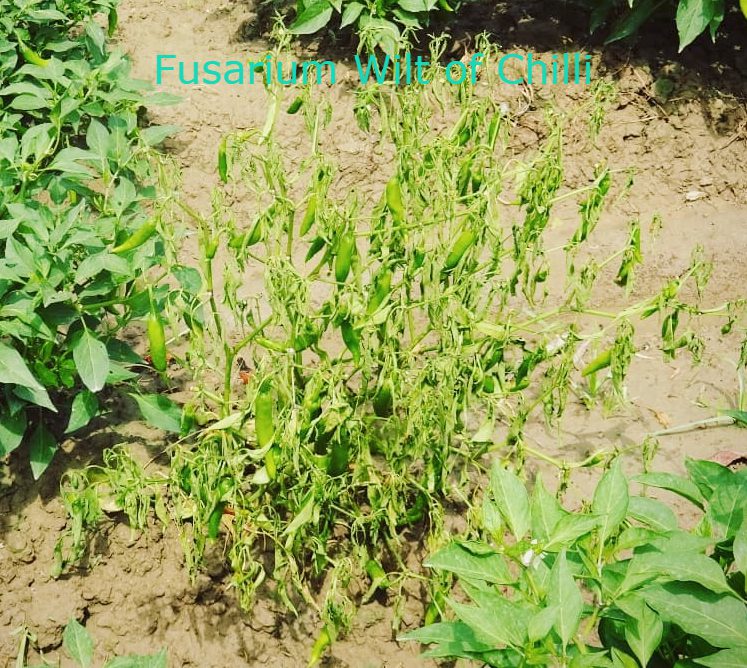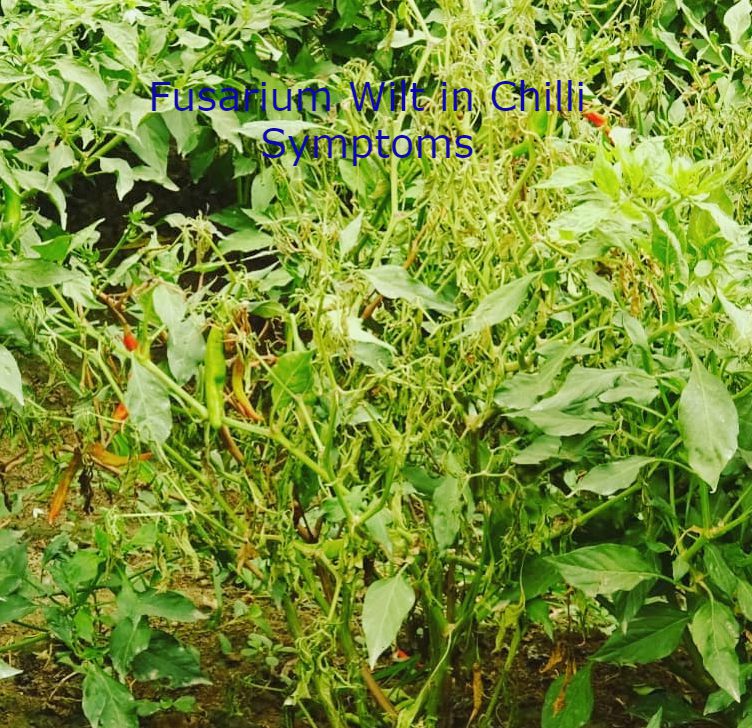Fusarium Wilt of Chilli
Fusarium Wilt of chilli is the most common destructive fungicide disease of the chilli plants. This wilt disease is caused by the pathogen fusarium oxysporum. Symptoms of Fusarium Wilt appear during the growing season. The Fusarium wilt disease impacted the plant’s water supply after entering through the roots. In the later stages of fusarium wilt, the chili plant’s stem dries up.
Chilli Diseases
As mentioned in some previous publications about the various diseases of Chili. So in this article, we will tell you about another dangerous disease of pepper. The wilt of Chilli is one of the most common fungus diseases. Which is a hazardous disease for the pepper plant. Fusarium Wilt of Chili causes irreparable damage to the plant. There is a marked decrease in plant production. Because the disease is not treated in time, the infected plant will not be able to bear fruit. The cause of this disease is the Fusarium Oxysporum pathogen. Barley enters from the roots of the chilis plant. Chilli plants affect the water supply channels. The disease spreads to the trunk. Stops water supply to plants. The plant withers.
Symptoms of Fusarium Wilt of Chilli
The signs and symptoms of Fusarium wilt of chilli disease typically manifest themselves after the seasons have changed. The older leaves are the first to succumb to this illness. After that, it affects the entire plant and causes it to dry out, and the process continues indefinitely.


Fusarium wilt of Chilli is Caused by
The fusarium wilt-causing fungus Fusarium oxysporum f. sp. lycopersici contains three unique “races” or strains. Fusarium wilt is capable of infecting tomatoes, eggplants, and peppers. It may eat mallow and crabgrass, among other weeds, to survive. The fungus thrives at temperatures over 82 degrees Fahrenheit, and its virulence rises in acidic soil. Typically, the pathogen penetrates the plant through holes or fractures in the roots caused by cultivation or nematode feeding. Even though Fusarium wilt can be transferred by seed, it is quite rare in commercial seed.
The most prevalent vectors of infection are infected transplants or instruments that have been in contact with fungus-infested soil. Through the vascular system of the plant, the infection ascends. Once a plant has been infected, the disease does not often spread to other plants within the same growing season. As latent chlamydospores, the fungus can persist for an extended period of time in soil or plant debris. Extremely rarely does the wind transport spores over huge distances.
Causal Organism Wilt of Chilli
The causal organism of Fusarium wilt of chilli is the soil-borne fungus Fusarium oxysporum f. sp. capsici.
Disease Cycle of Fusarium Wilt of Chilli
The fusarium wilt bacterium can survive for many years in the soil. Attacks again when the conditions are favorable. Water, insects, and agricultural implements all contribute significantly to its spread. This fungus disease thrives in warm conditions and is most dangerous when the soil temperature reaches 27 degrees Celsius. The season for disease transmission is characterized by dry weather and parched soil.
The Fusarium wilt of chilli disease cycle begins when the fungal pathogen, Fusarium oxysporum f. sp. capsici, enters the plant through wounds or natural openings. Once the pathogen has entered the plant, it begins to spread throughout the vascular system, causing a blockage in the flow of water and nutrients. This leads to wilting, yellowing, and stunted growth of the plant. Eventually, the plant may die.
The pathogen can spread from plant to plant by water splash, contaminated pruning tools, and insect vectors. The spores of the fungus can also survive in the soil for up to 10 years and can be spread from contaminated soil to healthy plants. Once the plant is infected, the fungus produces toxins that are toxic to the plant. These toxins can cause further damage by disrupting the plant’s ability to take up nutrients and water, leading to further wilting and stunted growth. To control the spread of Fusarium wilt of chilli, crop rotation and preventive measures such as maintaining adequate soil fertility, avoiding overhead irrigation, and removing infected plants are recommended. Chemical fungicides can also be used to control the disease.
Fusarium Wilt of Chilli Disease Treatment
should engage in cultivating those varieties of chili that are immune to the disease known as fusarium wilt of chilli. It is important to treat the seeds of the chili plant with fungicide before beginning cultivation.
- Remove the disease-spreading insects from the chili field.
- High-pH soils are more sensitive to diseases and produce poorer crop yields. Therefore, low-pH fertilizers should be employed.
- Most nitrogen fertilizers raise the soil’s pH, hence it is advised to use nitrogen fertilizers sparingly and low-pH fertilizers.
Spray the field regularly to eliminate weeds. When there are few weeds, remove them by hand (hand Picking Method). If they are high, use the spray to subdue them. Use a spray for Fusarium Wilt Disease of Chili chemical control if the attack is severe. Always choose a reputable spray company and observe all safety procedures when spraying.
Fusarium Wilt of Chilli Chemical Control
The chemical control of Fusarium wilt of chilli includes the use of fungicides such as carbendazim, mancozeb, thiophanate-methyl, propiconazole, and metalaxyl. These should be applied to the soil prior to planting and periodically throughout the season. Additionally, crop rotation and proper sanitation practices should be employed to reduce the spread of the disease.
Fusarium Wilt of Chilli Organic Control
Organic control of Fusarium wilt of chilli includes:
- Use of resistant varieties: Try to grow resistant varieties of chilli that are less susceptible to Fusarium wilt.
- Crop rotation: Crop rotation is a very important tool in controlling Fusarium wilt. Rotate your crops with some other non-susceptible crops such as corn, sorghum, oats, and wheat.
- Sanitation: Maintain a clean and hygienic environment in and around the field. Remove and discard the infected plants and debris in the field.
- Soil solarization: Solarization of the soil by covering it with a transparent plastic sheet can help in getting rid of the Fusarium spores.
- Biological control: Use beneficial fungi, bacteria, and nematodes to control the Fusarium wilt of chilli. Bacillus subtilis and Trichoderma harzianum are some of the beneficial organisms that can be used for this purpose.
- Avoidance of irrigation water accumulation: Avoid accumulation of irrigation water in and around the field as it can help in the spread of Fusarium wilt.
- Use of organic fertilizers: The use of organic fertilizers such as compost, green manure, and animal manures can help in building healthy soil and can help in controlling Fusarium wilt.

